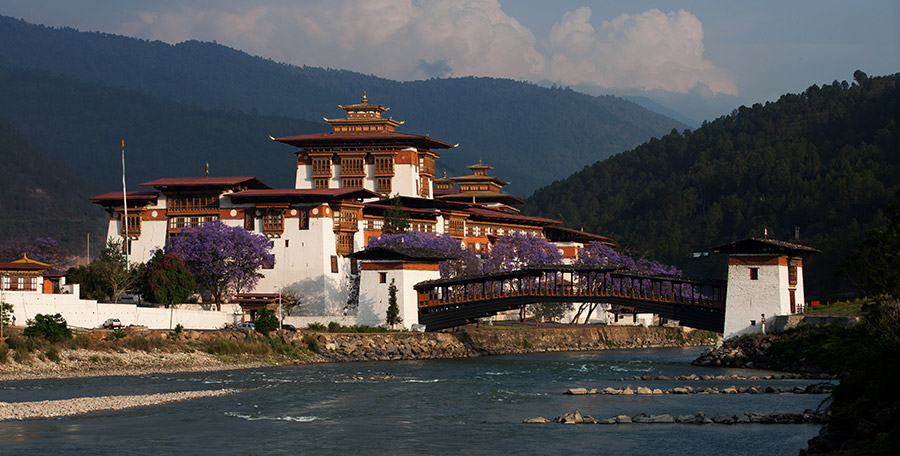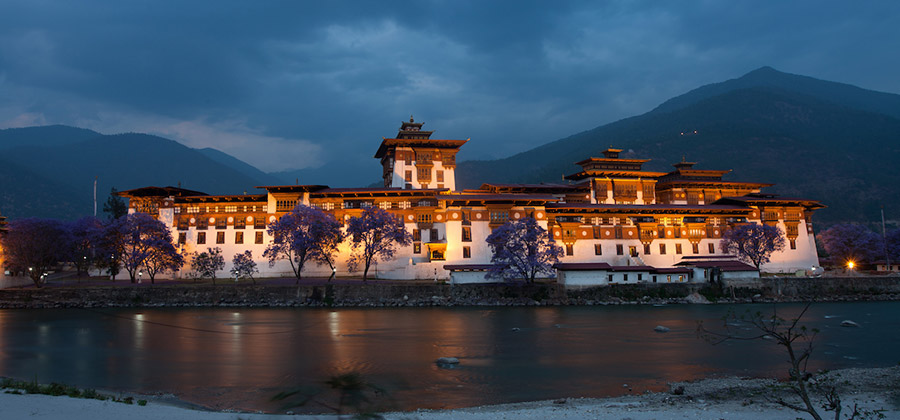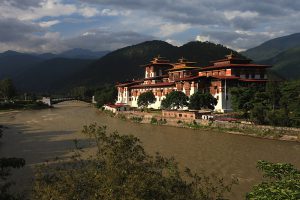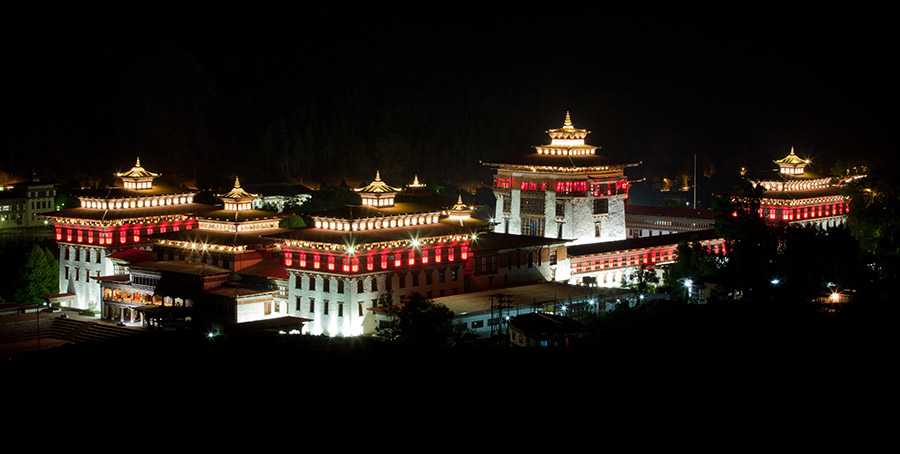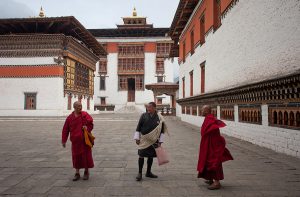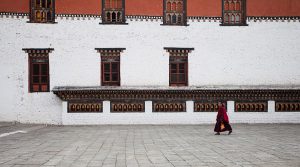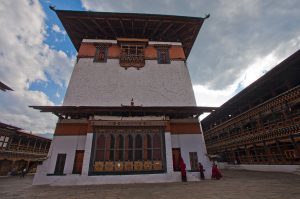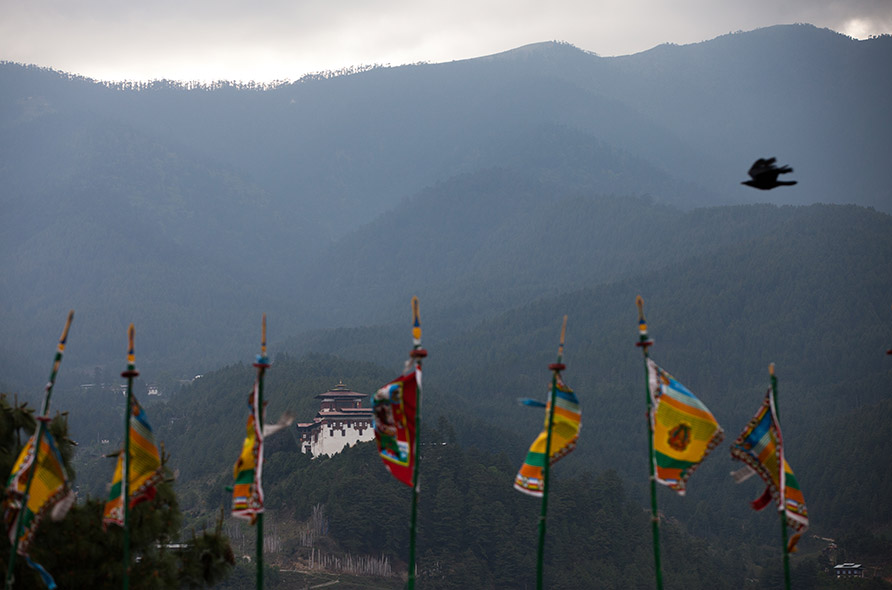Also see: our upcoming travel photography tour to Bhutan
(For best viewing experience, click on any image to see larger size and click on left/right arrows to move to the prev/next image)
As my aircraft zigzags through the valley flying dangerously close to the mountains on either side on its approach to Paro, an oversize white-washed structure catches my attention. Its tall windowless walls reached almost five-stories high and tapered inwards as they gained height. At the center of it was a tower that reached twice as high as the walls, surrounded by what seemed from the air to be delicate woodwork and roofed by traditional tiles. It was so big, it seemed to be capable of consuming half the town’s population. As the rubber brushed the tarmac with a mild jolt of the abrupt landing–Paro airport is supposed to be among the most difficult places in the world to land at–I wondered what this charming building may be.
Later, as I drove from airport to the hotel and spent time all around the town, the big building never seemed to fade away from the view. The town was easily dominated and overshadowed by what turned out to be a dzong, or a fortress.Dzongs are administrative edifices seen across Bhutan, which serve multiple purposes. Traditionally, they hosted the rulers and the military establishment, protecting them from the enemy and using it as a safe base to fight the war from. It was also a place of residence for monks, as the monastic bodies in Bhutan have always claimed as much importance as the administrators.
Today, each district in Bhutan–there are twenty of them–has a dzong that hosts district office in one half and the monastic body in the other. Every dzong follows a traditional Bhutanese architecture, and that remains the case even if a new one is to be built today. Apparently, they are built with no written plan as the architects have the ancient knowhow and do not require the support of written drawings to get the building up in place. They are also claimed to be built without hammering a single nail anywhere in the whole construction.
There are possibly not too many structures anywhere in the world that may be as charming as the dzongs of Bhutan. They are often located in picturesque locations – almost always next to a river, slightly high up from the base of the valley at a place clearly visible from almost any part of the town. Bhutan’s mountain landscapes–untouched slopes covered in greenery and occasional eruption of prayer flags amidst them–almost always form the background and add to the dzong’s appearance.
For a photographer, the evening floodlights on the dzongs add a great deal of pep to an already beautiful visual. Here is a collection of images of a few dzongs from across Bhutan.
Punakha Dzong (above) stands out spectacular among all those beautiful dzongs spread across the country. In summer, especially in May, Jacaranda trees surrounding the building bring in a dash of purple to the white-and-wood architecture. Add two rivers that flow on either side of the dzong and their confluence near the northern wall, and you have a place that might seem too beautiful to be true. Add tall mountains all around it, and there will be no more words left to describe how enchanting this place can be.Above: More images of Punakha Dzong
Nearly all dzongs are lit with floodlights in the evening hours, much to the delight of photographers. Especially charming in the night is Tashicho Dzong in Thimphu, which is the power center of all of Bhutan. The bright-red and yellow light to the windows at the top make them more colourful than any other dzongs in the country.
Tashicho Dzong is the largest dzong in the country. It is so huge that you will have to climb up the nearby hills to be able to get an end-to-end photograph of the building. It’s surroundings are beautifully decorated with tall trees and a garden that looks elysian. From the inside, the vast spaces make Tashicho Dzong appear even more magnanimous. It’s tall walls, empty courtyards and huge tower make the scale of the structure very apparent.Above: More images of Tashicho Dzong, Thimphu.
In comparison, the dzong at Paro appears relatively plain from the outside. But once you enter inside, you are again surprised by the scale of the architecture, the tallness of the central tower and also how alive the whole place is!
Above: More images of Paro Dzong.
And finally, an image of Jakar Dzong in the remote Bumthang Valley. As other dzongs, this one too dominates everything else in the valley and stands tall in a truly dramatic location.
Also see: our upcoming travel photography tour to Bhutan

